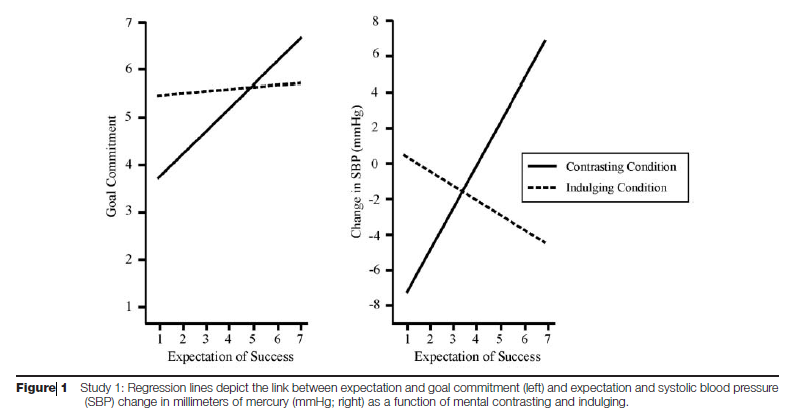Wouldn’t it be great if you were more likely to achieve success in your goals, just because you take the time to think about the positive outcomes?
This is part of the promise of books like The Secret. That visualization and positive thinking can help you achieve just about anything.
But is there any real scientific research backing up these ideas?
Well, there is, and it is known as mental contrasting, but the results are fairly controversial.
In this post, we shall discuss exactly what mental contrasting is and is not. We shall look at the good and bad of mental contrasting. A little look at some of the concerns about mental contrasting (the ugly). And then we shall look at a lot of the research behind mental contrasting and how it applies to modern positive psychology.
Now, let’s get back to it…
What is Mental Contrasting?
Mental contrasting is a visualization technique developed by Gabriele Oettingen, a motivation psychologist who wished to improve the effectiveness of traditional self-control strategies like positive-future visualization.
The technique has strong empirical support. For example, it has been shown to:
- Improve academic performance, leading to high quiz grades and significantly more time spent preparing for standardized tests.5,7
- Improve health, prompting more exercise, less unhealthy snack consumption, and more fruit intake. 4,8,9
- Increase help seeking and help giving behavior.2
- Increase the likelihood of taking steps to reduce cigarette consumption.3
Before going into the specifics of the technique, there is one important caveat – the impact of the technique is dependent on expectations of success.
When people who expect to succeed use mental contrasting it works quite well. When used by those with high expectations of success leads to increased goal commitment and energization.
But when mental contrasting is used by people with a low expectation of success, it does not have wonderful results. When used by those with low expectations of success it leads to reduced goal commitment and demotivation.
So you have been warned and the main “bad” of mental contrasting has been mentioned. Let's dig into the details on how mental contrasting actually works.
31 Benefits of Gratitude you Didn't Know About
Mental Contrasting is Simple
The “how to” of mental contrasting is pretty simple. In fact, you may have done it before, but just heard it labeled as “visualization”. While “visualization” and “mental contrasting” are not exactly the same thing, they are very close.
Here is how you do mental contrasting:
1a) Write down or think about several positive aspects associated with completing your goal. For example, if you're trying to lose weight, those positive aspects could be: looking good, living longer, spending less on healthcare, feeling more lively, being able to stay active, getting your spouse to stop nagging you, etc…
1b) Hone in the most positive aspects. This could be one especially large benefit or a few smaller ones. Then take a few moments to visualize those benefits. The longer and the more detail, the better.
2a) Write down or think about several obstacles in the way of you completing your goal. For example, if you're trying to lose weight, those obstacles could be: being tempted by snacks, purchasing unhealthy food while shopping, eating too much at dinner, emotional binging, lack of motivation to exercise, etc…
2b) Hone in the largest obstacles. This could be one especially large obstacle or a few smaller ones. Then take a few moments to visualize those obstacles. The longer and the more detail, the better.
That's it. Visualize your goal. Visualize your obstacles. Mental contrasting complete.
Sounds simple, and it is.
In many of the studies in which mental contrasting was tested, participants were instructed to use the technique just once – taking just a few minutes. Afterward, changes in behavior were observed for up to several weeks.
On average, I use this technique once a week. However, once a day is likely more effective.

Mental Contrasting is Not for the Uncertain
In nearly all studies which tested the impact of mental contrasting, those with a lack of confidence were hurt by the technique.1,2,3,5,8
This is not a technique which should be used to bolster confidence. Instead, this technique translates cerebral thoughts of success into concrete emotions of motivation.
If you are confident in your success, mental contrast can increase your chances of success. If you lack self-confidence it might be a hindrance.
For example, in one study, those in the mental contrasting condition who had low expectations of success did three times as worse as those in the control condition. If you're not confident of success, don't use this technique. Unless that is, you'd like to internalize that lack of confidence.
In some cases, it may make sense to reduce commitment towards unattainable goals. That way, time and energy can be freed up for more reasonable goals – ones which better match your capabilities.
How to Be Happy: 54 Ways to Find Happiness
Why Was Mental Contrasting Developed?
When a book, website, or coach recommends visualization, often, they are referring to a positive-future visualization version of mental contrasting.
They are suggesting that you visualize the completion of your goal – of having attained the rewards lying at the end of the road. Consider things from the perspective of your subconscious.
Positive-future imagery works when you limit your imagery to reality. Obviously visualizing yourself as the Rick Grimes type hero in a zombie apocalypse is not going to achieve much.
But when you ground your imagery in reality, the brain reacts to careful planning and consideration. It helps to motivate you to success because if you can conceive it, you can achieve it.
That's why positive-future visualization works – it convinces your brain that your desired future is likely to come true, “if I can visualize it, it must not be that hard to acquire.“
The Positive-future imagery part is good for those with lower self-confidence.
However, this type of imagery breaks down for those with greater self-confidence. If you're reasonably confident but just lack motivation, positive-future visualization has been shown to hurt more than it helps.
The reason is simple – your brain assumes the goal is easier to acquire than it actually is. That's a problem – because your subconscious is hyper-efficient, it allocates only as much energy as is needed to accomplish its goals – anything more would be a waste. If it thinks that your goal will be extra easy to accomplish, it will allocate less energy.
This phenomena, called de-energization, has been experimentally observed and induced and leads to reduced goal commitment and attainment.1
To combat this problem, mental contrasting was developed. As a means for people with more confidence in their success of using it as a motivational to keep them motivated for success.
Mental Contrasting Vs. Visualization
If you are confident in the success in your goals. Try mental contrasting as a means to keep yourself motivated.
If you lack confidence in the success of your goals. Only use the positive-future imagery (visualization) part. This will help your subconscious feel that you can succeed.
Why Does Mental Contrasting Work?
The subconscious mind has a short time-horizon – it acts based on emotion, habit, and desire.
The reason for generating motivation for our long-term goals can be so difficult isn't because the subconscious doesn't care – it wants you to be healthy, wealthy, and happy. The problem is that it doesn't understand.
You understand why it's good to get off your butt and go running outside. It'll help burn fat and get your cardiovascular system in shape.
But your subconscious sees it as a pointless waste of energy, “what good is running around in a circle?”
You understand why it's good to type away at the keyboard, getting your work done. It'll help you produce quality work, which will get you promoted and allow you to make more money. But your subconscious sees it as pushing little buttons over and over again – as a completely pointless waste of time.
Mental contrasting helps your subconscious understand. It ties together the promise of future reward with obstacles which must be overcome in the present (e.g. do x,y, and z,, and you will receive your reward).
You, the conscious, already understand. Your subconscious speaks in images, which is why your thoughts of grandeur and accomplishment fail to help it understand.
But visualization in the form of mental contrasting? That works.
This idea has been reduced to certain concrete changes in the brain – mental contrasting, when combined with high expectations of success, this leads to an increased neuronal connection between the obstacle and future reward. That is, climbing the stairs gets more strongly associated with health.8
Concerns and Questions about Mental Contrasting
Okay. I am stretching a bit for the “ugly” That was mostly a conceit to make a snappy title. But there are some real concerns with the idea of mental contrasting
There are several concerns and questions which remain unaddressed regarding this technique:
- Why have so few researchers besides Gabriele Oettingen investigated and replicated the effectiveness of this technique?
- What is the long-term effectiveness of the technique? So far, only a few studies have tested for periods longer than a few weeks.
- For what types of people is the technique especially useful or harmful? Surely, other variables besides expectations of success are at play.
- Given that mental contrasting is so harmful to people with low expectations, how can low expectations be readily and accurately identified?
- What is the dose-response curve? (e.g. is 10 minutes of mental contrasting twice as effective as 5 minutes? Is once a day seven times more effective than once a week?)
9 Studies in Mental Contrasting
Study #1: Mental Contrasting and Goal Commitment
In many previous studies, expectations of success have been found to impact the usefulness of mental contrasting. This study explored one possibility for how expectations of success + mental contrasting can lead to changes in goal commitment — energization.
In this study, participants were dived into two groups, both of which had their blood pressure measured. Blood pressure was used as a proxy for energization. As hypothesized, those with high expectations of success in the mental contrasting condition increased short-term energization by 50%.
However, expectations of success explained less than 25% of the variance in blood pressure, which in turn explained less than 20% of the variance in goal commitment – clearly, many other important variables lie unobserved. Energization may not be the only mediator.
In addition, as many participants had low expectations of success, mental contrasting actually reduced energization for about 50% of participants. This can be seen in the graphs below.

1. Oettingen, G., Mayer, D., Sevincer, A. T., Stephens, E. J., Pak, H. J., & Hagenah, M. (2009). Mental contrasting and goal commitment: The mediating role of energization. Personality and Social Psychology Bulletin, 35(5), 608-622.
Study #2: Mental Contrasting and the Self Regulation of Helping Behavior
In this study, two questions were explored – does mental contrasting impact the likelihood of 1) asking for help and 2) giving help, and is the impact expectancy dependent? Participants were asked to go through the visualization procedure just once and then report back on the results two weeks later.
When students were asked to mentally contrast, those with high expectations of success were about 20% more likely to seek out and receive help for a specific, self-selected task (get a good grade, internship advice, etc…).
Those with high expectations of success were five times more likely to receive help than those with low expectations of success. That's because mental contrasting hurt about 50% of participants – those with the lowest expectations of success performed four times as well in the control condition than in the mental contrasting condition.
Those students asked to dwell on the negative performed about half as well as the other conditions.
When nurses were asked to mentally contrast, those with high expectations of success expended about 50% more energy trying to improve communication with their patient’s relatives. However, mental contrasting hurt those with low expectations of success, reducing their effort over the following 2 weeks by up to 80% – to near zero.
2. Oettingen, G., Stephens, E. J., Mayer, D., & Brinkmann, B. (2010). Mental contrasting and the self-regulation of helping relations. Social Cognition, 28(4), 490-508.
Study #3: Self-regulation of Commitment to Reduce Cigarette Consumption
This study explored whether mental contrasting could be used to help cigarette addicts cut back on their consumption.
The results were positive; however, the methodology chosen was more suggestive than concrete – rather than measuring consumption of cigarettes and seeing if the mental contrasting condition reported a downward trend, the study tracked days until first step taken.
Those in the mental contrasting condition with high expectations of success took their first step towards completing their goal two to three times faster than those in the other conditions.
However, those with low expectations of success took two to three times longer to make the first step. The question is, how much does the immediacy of action impact long-term consumption behavior?
3. Oettingen, G., Mayer, D., & Thorpe, J. (2010). Self-regulation of commitment to reduce cigarette consumption: Mental contrasting of future with reality. Psychology and Health, 25(8), 961-977.
Study #4: When Planning is Not Enough
This study explored whether mental contrasting used in combination with implementation intentions could improve eating behavior. Across all conditions, participants went through the visualization procedure once and were then asked to complete a food diary for the next week.
Those in the mental contrasting + implementation intentions condition consumed about 10% more pieces of fruit and got about 40% fewer calories from unhealthy snacks.
Those in the implementation intentions only condition did no better than those in the control condition; however, used in combination, increased the effectiveness of mental contrasting by more than 30%.
Of interest is the fact that the typical implementation intention procedure was not followed – participants were asked to visualize their intentions.
4. Adriaanse, M. A., Oettingen, G., Gollwitzer, P. M., Hennes, E. P., de Ridder, D. T., & De Wit, J. B. (2010). When planning is not enough: Fighting unhealthy snacking habits by mental contrasting with implementation intentions (MCII). European Journal of Social Psychology, 40(7), 1277-1293.
Study #5: Mental Contrasting Facilities Academic Performance in School Children
In this study, the usefulness of mental contrasting for improving the academic performance of children was explored. Students were asked to either mental contrast of positive-future visualize regarding a quiz they would be taking in two weeks.
The results were suggestive – compared to the positive-future condition, students in the mental contrasting condition scored 20 to 35% higher on their quizzes. Expectations of success moderated some of the impact of mental contrasting on performance
5. Gollwitzer, A., Oettingen, G., Kirby, T. & Duckworth, A. L. (2011). Mental contrasting facilitates academic performance in school children. Motivation and Emotion, 35, 403-412.

Study #6: Mental Contrasting Promotes Integrative Bargaining
This study explored whether mental contrasting could improve bargaining performance.
Students were given a hypothetical bargaining situation to play out. Those who performed well were told they would be entered into a lottery for a chance to win $200. Those in the mental contrasting condition earned about 5% more points, most of which were acquired by compromising with their ‘opponents’.
Although the result was statistically significant, in an absolute sense, it was small.
6. Kirk, D., Oettingen, G., & Gollwitzer, P. M. (2011). Mental contrasting promotes integrative bargaining. International Journal of Conflict Management, 22(4), 324-341.
Study #7: Self-Regulation Strategies Improve Self-Discipline in Adolescents
This was another study which explored the usefulness of mental contrasting for improving the academic performance of children.
Before the start of summer break, students were either assigned to a mental contrasting or a control condition. Both conditions were then given 10 practice PSAT books, to be used as desired. For those unfamiliar, the PSAT is a practice exam – it counts for nothing, and is used to gauge readiness for the SAT.
By the end of the summer, those in the mental contrasting condition completed 60% more practice questions than those in the control condition. I'm concerned by those results – quite simply, they're fantastical.
A 10-minute visualization was able to produce hours of additional effort. Again, for those not familiar, PSAT practice books are extremely boring.
7. Duckworth, A. L., Grant, H., Loew, B., Oettingen, G. & Gollwitzer, P. M. (2011). Self-regulation strategies improve self-discipline in adolescents: Benefits of mental contrasting and implementation intentions. Educational Psychology: An International Journal of Experimental Educational Psychology, 31(1), 17-26.
Study #8: Mental Contrasting Instigates Goal Pursuit by Linking Obstacles of Reality With Instrumental Behavior
In this study, the question of how mental contrasting works was explored. In particular, the idea that it works by linking the completion of existing obstacles with the promise of future reward was tested.
In the first study, the ability of mental contrasting to link those two mental concepts was tested using a sequential priming task (read the paper for the details). In cases of high expectancy, linkage increased. In cases of low expectancy, linkage decreased. The result was significant – both statistically and in an absolute sense.
In the second study, the impact of the linkage on actually changing behavior was tested. Participants who wanted to become more fit were recruited.
Those in the mental contrasting condition with high expectations of success had stronger linkage (again, measured through a sequential priming task), and were up to 25% more likely to be observed using the stairs rather than the elevator (to change locations in the building, as part of the study).
In contrast, those with a low expectation of success showed reduced linkage, as well as less instrumental behavior – they were almost half as likely to use the stairs.
A few questions remain unanswered:
- How long does the linkage last?
- What frequency of visualization is needed in order to maintain the connection?
- How much can mental contrasting strengthen the connection?
- Why did the reverse contrasting condition show the exact opposite results of the mental contrasting condition (low expectations of success – higher linkage; low expectations of success – more likely to use the stairs)?
- Does this imply that those with low expectations of success should use reverse contrasting?
8. Kappes, A., Singmann, H., & Oettingen, G. (2012). Mental contrasting instigates goal pursuit by linking obstacles of reality with instrumental behavior. Journal of Experimental Social Psychology, 48(4), 811-818.
Study #9: Mental Contrasting of a Dieting Wish Improves Self-Reported Health Behavior
This was another study which explored the usefulness of mental contrasting for improving the pursuit of health-related goals.
Participants were either instructed to mental contrast or positive-future visualize regarding a dieting goal. Then, two weeks later, they were asked to report on progress (e.g. relative to usual, how much did you exercise, eat high-calorie food, etc…).
Those in the mental contrasting condition were estimated to consume about 100 fewer calories per day (compared to 50 for control) and were 30% more likely to have reported increasing their exercise activity (compared to 15% for control).
9. Johannessen, K. B., Oettingen, G., & Mayer, D. (2012). Mental contrasting of a dieting wish improves self-reported health behavior. Psychology & Health, 27 (sup2), 43-58.
Final Thoughts on Mental Contrasting
Mental contrasting can help clarify your goals and aspirations by vividly imagining the desired future outcomes and then contrasting them with the current reality. This enables you to identify potential obstacles and develop effective strategies to overcome them.
By engaging in mental contrasting, you can enhance your motivation, increase your self-awareness, and make more informed decisions to bridge the gap between your current situation and your desired future.
Now, for a bit of inspiration to help you envision a better future, watch the video below about the classic story about the elephant and the rope to learn how your beliefs are holding you back and why you need to break free.
Finally, if you're looking for more helpful resources, check out these blog posts:
- 7 Visualization Techniques to Create a Better Life
- Visualizations Techniques – Without the Bullshit!
- Goal Setting Theory



Thank you for this post.
I work ad a Continuous Improvement Specialist. I work to develop problem solving capabilities withing my organization and am using a model developed by Mike Rother which he calls the Improvement Kata and Coaching Kata. According to his research, this is the structured thought habit that has made Toyota Motor Company so successful over the years. The Improvement Kata is very parallel to MCIIP Visualization with an emphasis on the scientific process and generating continuous learning within an organization. It is very enlightening to better understand the psychology behind such a thought model and I am considering the implications of a pessimistic approach to this actually causing more harm than good and what can be done about it.
Hi Amin, thanks for this blog! I am working with youth in a coaching facility, so I appreciate you highlighting the challenges to the WOOP method.
You list out the following question: Given that mental contrasting is so harmful to people with low expectations, how can low expectations be readily and accurately identified?
Has there been any additional work done on this front? I am in a place where I am currently trying to figure out if there is a place to use mental contrasting and I would find additional info on how to identify those with low expectations of success very helpful